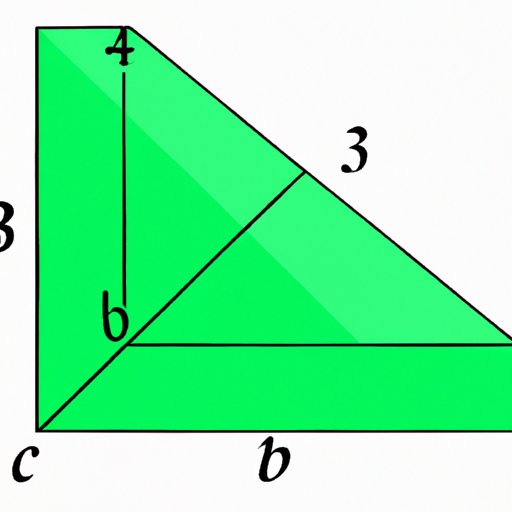
I. Introduction
A rhombus is a four-sided shape in which all sides are equal in length. It is similar to a square, but its opposite angles are not 90 degrees. The importance of finding the area of a rhombus lies in its practical applications in fields such as geometry, architecture, and engineering. In this article, we will discuss how to find the area of a rhombus in simple steps, using various methods.
II. Discovering the Formula for Finding the Area of a Rhombus
The formula for finding the area of a rhombus is simple and straightforward. The area is equal to the product of the two diagonals divided by two. That is:
Area of a Rhombus = (Diagonal 1 x Diagonal 2) / 2
To use this formula, follow these simple steps:
- Measure the lengths of the two diagonals of the rhombus. Ensure that the measurements are accurate to achieve an accurate result.
- Multiply the two diagonals together.
- Divide the product obtained in step two by two.
These three simple steps will give you the area of the rhombus in square units.
Let’s look at an example to make this clearer. Suppose you have a rhombus with diagonals measuring 8 cm and 6 cm respectively. To find the area of the rhombus:
- Multiply the two diagonals together: 8 x 6 = 48.
- Divide the product obtained in step one by two: 48/2 = 24.
The area of the rhombus is 24 cm².
III. Visualizing the Area of a Rhombus
Visual aids provide a useful tool for facilitating understanding and retention of abstract concepts such as the area of a rhombus. Diagrams and illustrations are excellent tools for demonstrating how the area of a rhombus is derived. You can use these to illustrate the diagonals and show how the formula for finding the area of a rhombus is derived.
Interactive tools such as animations and videos can be used to make the learning process fun and engaging. For example, you can use an animation to show how the diagonals intersect at the center of the rhombus and how the area is calculated.
IV. Applying the Area of a Rhombus to Real-Life Scenarios
Knowing how to find the area of a rhombus has several practical applications in real-life scenarios. For instance, architects and engineers use the area of a rhombus to calculate the amount of material needed to cover a rhombus-shaped roof. Similarly, landscapers use the area of a rhombus to determine the amount of turf required to fill a rhombus-shaped garden bed.
Another practical application of the area of a rhombus is in solving everyday problems. For example, suppose you’re renovating your living room. You want to decorate the room with a rhombus-shaped carpet, and you need to know how much carpet to buy. Knowing how to find the area of a rhombus will enable you to calculate the size of the carpet you need to purchase.
V. Mastering the Area of a Rhombus: Common Mistakes to Avoid
Like with any other mathematical concept, it’s easy to make mistakes when finding the area of a rhombus. Some of the common mistakes people make include incorrect measurement of the diagonals, swapping the diagonals when applying the formula, and forgetting to divide the product of the diagonals by two. To avoid these mistakes, follow these simple tips:
- Ensure that you measure the diagonals accurately. A tiny error can significantly affect the result.
- Always multiply the longest diagonal first.
- Double-check your calculations before arriving at your final answer.
Practice is key to mastering the area of a rhombus. You can reinforce your understanding and improve your problem-solving skills by solving exercises or problems that test your ability to find the area of a rhombus. These exercises can help you identify areas where you need to improve and build your confidence.
VI. Rhombus Area Challenge: Test Your Skills
Here are a few challenging problems to test your skills in finding the area of a rhombus. Take your time, show all working, and don’t forget to check your answers using the formula.
- A rhombus has diagonals of length 15 cm and 12 cm. Find its area.
- The diagonals of a rhombus are 14cm and 48cm. Find its area.
- A rhombus has a perimeter of 32 cm and an altitude of 10 cm. Find its area.
- The area of a rhombus is 432 cm². The length of one diagonal is 27 cm. What is the length of the other diagonal?
The answers to these problems are:
- 90 cm²
- 336 cm²
- 80 cm²
- 32 cm
Don’t worry if you didn’t get the answers right away. Keep practicing, and you’ll eventually get better!
VII. Conclusion
Understanding how to find the area of a rhombus is essential in fields such as architecture, engineering, and geometry. In this article, we discussed the formula for finding the area of a rhombus and its application in real-life scenarios. We also explored common mistakes people make when finding the area of a rhombus and provided tips for avoiding those mistakes. To reinforce your understanding, we included a set of challenging problems with step-by-step solutions.





